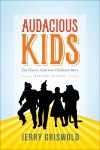Guest post by Jerry Griswold
“‘Twas the night before Christmas” begins Clement Moore’s “A Visit from St. Nicholas,” that immortal poem generally credited with popularizing Dutch customs (Santa and gift-giving) and shaping the American holiday as we know it. But, as I suggest in my study of American childhood classics called Audacious Kids, a case might be made for Mary Mapes Dodge as the real popularizer of American Christmas customs and for her novel Hans Brinker as even more appropriate holiday reading than Moore’s verses about the “right jolly old elf.”
These days Dodge is mostly remembered by literary historians as the able editor (1873-1905) of St. Nicholas, America’s premier periodical for children. Well before adults picked up the Harry Potter books or made bestsellers of the Hunger Games series, Dodge was mingling young and old readers by persuading the majors to write for minors. The list of people she got to write for her magazine reads like a Who’s Who: Louisa May Alcott, Jack London, Mark Twain, Rudyard Kipling, Robert Louis Stevenson, William Cullen Bryant, Henry Wadsworth Longfellow, Helen Hunt Jackson, Frank Stockton, Lucretia P. Hale, Susan Coolidge, Howard Pyle, Joel Chandler Harris, Edna St. Vincent Millay, and Kate Douglas Wiggin.
Dodge revered Christmas. Her first publication was “A Song of St. Nicholas” and her subsequent work, especially as editor of St. Nicholas, was full of talk of Santa and Christmas. Her beloved classic Hans Brinker is no exception. The events of the novel occur during the holiday season. Stories about and songs to St. Nicholas abound. An extended glimpse of a Dutch family’s Christmas is provided. And a lengthy discussion of the difference between Dutch and American ways of celebrating begins with a reference to Moore’s poem: “We all know how, before the Christmas tree began to flourish in the home life of our country, a certain ‘right jolly old elf,’ with ‘eight tiny reindeer,’ used to drive his sleigh-load of toys up our housetops.”
But there is another thing that makes Hans Brinker especially appropriate holiday reading.
The typical Christmas story is touching. Consider: Hans Christian Andersen’s Little Matchgirl freezing to death in the streets of an uncaring world while others celebrate indoors around their Christmas trees; the March sisters sacrificing their Christmas dinner to the poor German family in Little Women; or the gifts of a hairbrush and watch chain to the shorn wife and watch-less husband in O’Henry’s “The Gift of the Magi.” The classic films of the season, Miracle on 34th Street and It’s a Wonderful Life, likewise offer the sentimental.
In that regard, Hans Brinker is a tearjerker that serves up the sentimental in aces. It tells the story of the pathetic and penniless Brinker family; the head of the household is a dazed lunatic and his wife (called “Widow Brinker”) needs to depend upon the work of her two children (Hans and Gretel) for the few morsels in their house. But in a conclusion which is guaranteed to bring tears to your eyes, the paterfamilias endures perilous surgery and is brought back to his senses, Hans and his mother are finally happy, Gretel wins the race for the Silver Skates, and even the surgeon is reunited with his estranged son. If the touching story is requisite for this time of year, then Dodge trumps Moore because while “A Visit from St. Nicholas” ends with stockings stuffed, Hans Brinker ends with families reunited and everyone home for the holidays.
 Jerry Griswold’s most recent book is Audacious Kids: The Classic American Children’s Book. He is also the author of Feeling Like a Kid: Childhood and Children’s Literature.
Jerry Griswold’s most recent book is Audacious Kids: The Classic American Children’s Book. He is also the author of Feeling Like a Kid: Childhood and Children’s Literature.
